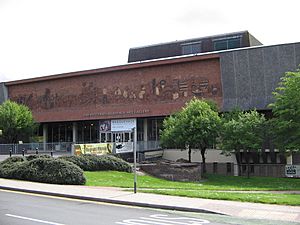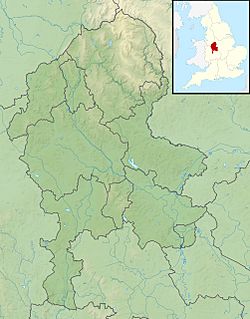Leekfrith torcs facts for kids
Quick facts for kids Leekfrith torcs |
|
|---|---|

The Leekfrith torcs (bracelet centre-left)
|
|
| Material | Gold |
| Created | c. 400—250 BC |
| Discovered | December 2016 Leekfrith, Staffordshire, England |
| Discovered by | Metal detectorists |
| Present location | Potteries Museum & Art Gallery, Hanley |
The Leekfrith torcs are four amazing Iron Age gold torcs. They were found by two people using metal detectors in December 2016. This exciting discovery happened in a field in Leekfrith, which is in north Staffordshire, England.
The find includes three torcs for the neck and one smaller bracelet. They were all found close to each other. Experts believe these are the oldest gold jewellery items from the Iron Age ever found in Britain. After the discovery, archaeologists looked carefully at the area, but they didn't find any more objects.
What Are the Leekfrith Torcs?
One of the torcs is a smaller bracelet. It has cool designs on it, in a style called Celtic art. The other three are neck rings.
- The bracelet and one of the neck rings are made from twisted gold wire.
- The other two neck rings have special ends shaped like trumpets. One of these has broken into two pieces over time.
These gold items are very pure. They are about 74-78% gold, which is like 17-18 carat gold. They also contain some silver and a little bit of copper. The pieces weigh between 31 grams (1 oz) and 230 grams (8 oz). All together, they weigh over 350 grams (10 oz). This mix of metals is common for gold items from the Iron Age in Europe.
Experts like Julia Farley from the British Museum think the torcs were made in what is now Germany or France. They were likely created between 400 and 250 BCE. This time is known as the La Tène period.
Julia Farley said:
This unique find is of international importance. It dates to around 400–250 BCE and is probably the earliest Iron Age gold work ever discovered in Britain. The torcs were probably worn by wealthy and powerful women, perhaps people from the Continent who had married into the local community. Piecing together how these objects came to be carefully buried in a Staffordshire field will give us an invaluable insight into life in Iron Age Britain.
This means the torcs are very important for understanding the past. They might have been worn by rich and powerful women. These women could have come from other parts of Europe and joined local communities in Britain. Finding out why these items were buried helps us learn about life in Iron Age Britain.
How Were They Found?
Mark Hambleton and Joe Kania found the torcs. They were using metal detectors in a field in Leekfrith. This happened around noon on December 11, 2016. The men had permission from the landowner to search the field.
Before this, Mark and Joe had only found old Victorian coins. They had started metal detecting as a hobby about 18 months earlier. Mark used to go metal-detecting with his dad when he was younger.
They found the first three torcs separately. They were about 6 to 8 inches (15 to 20 cm) deep in the ground. Each torc was about 3.3 feet (1 m) away from the others. The very next day, they told an officer from the Portable Antiquities Scheme about their amazing find. This officer works at the Birmingham Museum and Art Gallery.
Several weeks later, the same men found the last torc in the same field. Archaeologists then checked the site very carefully. They confirmed that all the items had been found. They also didn't find any signs of an old settlement or a grave nearby. On February 26, 2017, the original metal detectorists even found a missing piece of the smallest torc!
The Torcs Go on Display

The discovery of the torcs was announced to the public on February 28, 2017. This happened at a special event at the Potteries Museum & Art Gallery in Hanley.
Later that day, a special meeting called an 'inquest' took place. At this meeting, the torcs were officially declared 'Treasure'. This means they are very important historical items under a law called the Treasure Act 1996. The person in charge of the meeting, Ian Smith, said the find was "exciting."
Because they were declared 'Treasure', museums could buy the torcs. An independent group of experts decided on the price. The money from the sale would then be shared between the people who found the torcs and the landowner.
Before they were valued, the torcs were shown to the public. They were on display at the Potteries Museum & Art Gallery from March 1 to April 2, 2017. Many people came to see them! In December 2017, the museum raised £325,000 to buy the torcs. Now, they are on permanent display at the museum for everyone to enjoy.
See also
 In Spanish: Torques de Leekfrith para niños
In Spanish: Torques de Leekfrith para niños


